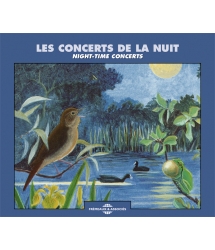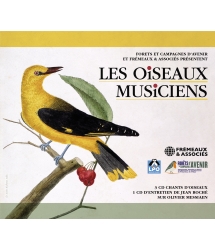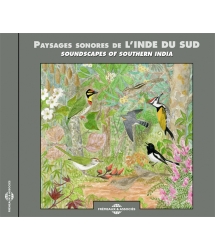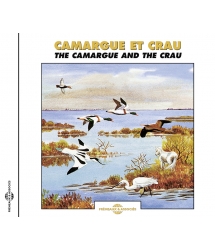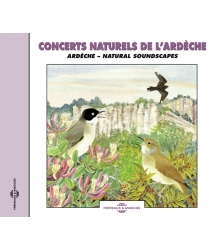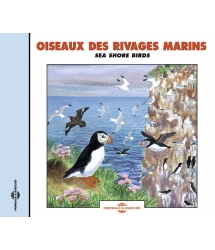- Our Catalog
- Philosophy
- Philosophers of the 20th century and today
- History of Philosophy (PUF)
- Counter-History and Brief Encyclopedia by Michel Onfray
- The philosophical work explained by Luc Ferry
- Ancient thought
- Thinkers of yesterday as seen by the philosophers of today
- Historical philosophical texts interpreted by great actors
- History
- Books (in French)
- Social science
- Historical words
- Audiobooks & Literature
- Our Catalog
- Jazz
- Blues
- Rock - Country - Cajun
- French song
- World music
- Africa
- France
- Québec / Canada
- Hawaï
- West Indies
- Caribbean
- Cuba & Afro-cubain
- Mexico
- South America
- Tango
- Brazil
- Tzigane / Gypsy
- Fado / Portugal
- Flamenco / Spain
- Yiddish / Israel
- China
- Tibet / Nepal
- Asia
- Indian Ocean / Madagascar
- Japan
- Indonesia
- Oceania
- India
- Bangladesh
- USSR / Communist songs
- World music / Miscellaneous
- Classical music
- Composers - Movie Soundtracks
- Sounds of nature
- Our Catalog
- Youth
- Philosophy
- News
- How to order ?
- Receive the catalog
- Manifesto
- Dictionnary











- Our Catalog
- Philosophy
- Philosophers of the 20th century and today
- History of Philosophy (PUF)
- Counter-History and Brief Encyclopedia by Michel Onfray
- The philosophical work explained by Luc Ferry
- Ancient thought
- Thinkers of yesterday as seen by the philosophers of today
- Historical philosophical texts interpreted by great actors
- History
- Books (in French)
- Social science
- Historical words
- Audiobooks & Literature
- Our Catalog
- Jazz
- Blues
- Rock - Country - Cajun
- French song
- World music
- Africa
- France
- Québec / Canada
- Hawaï
- West Indies
- Caribbean
- Cuba & Afro-cubain
- Mexico
- South America
- Tango
- Brazil
- Tzigane / Gypsy
- Fado / Portugal
- Flamenco / Spain
- Yiddish / Israel
- China
- Tibet / Nepal
- Asia
- Indian Ocean / Madagascar
- Japan
- Indonesia
- Oceania
- India
- Bangladesh
- USSR / Communist songs
- World music / Miscellaneous
- Classical music
- Composers - Movie Soundtracks
- Sounds of nature
- Our Catalog
- Youth
- Philosophy
- News
- How to order ?
- Receive the catalog
- Manifesto
- Dictionnary
SOUNDSCAPES OF SARDINIA
FREMEAUX & ASSOCIES
Ref.: FA686
Author : 23|130
Artistic Direction : BERNARD FORT
Label : Frémeaux & Associés
Total duration of the pack : 1 hours 12 minutes
Nbre. CD : 1
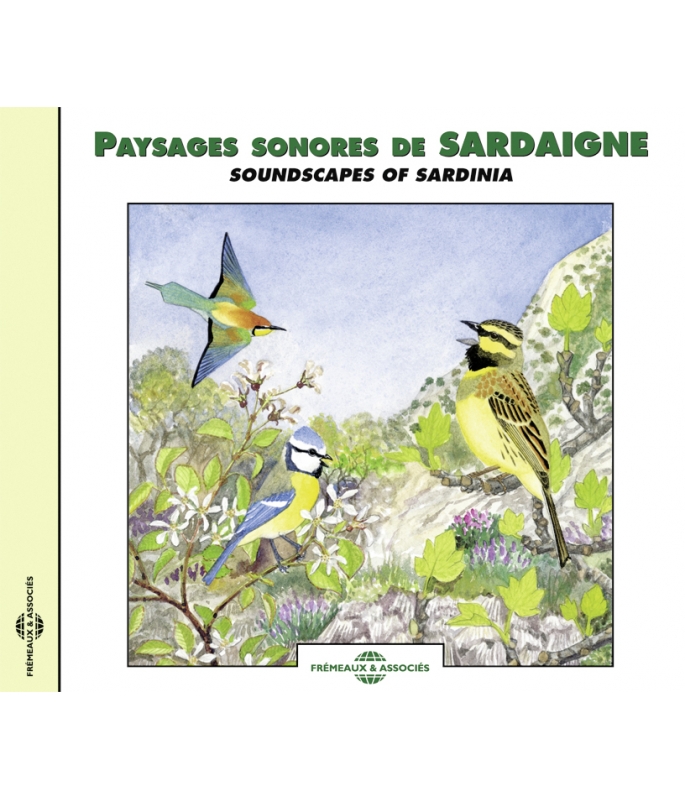
SOUNDSCAPES OF SARDINIA
SOUNDSCAPES OF SARDINIA
“All the sound landscapes presented here were recorded in the spring in various parts of Sardinia by Bernard Fort. From the coast to mountain tops, passing through the extensive central plains and wetlands, the great variety of landscape can be found in the different soundscapes each one provides. The acoustics particular to each site, perfectly recorded in this CD, reveal Sardinia’s captivating and wild beauty.” Patrick FRÉMEAUX
-
PisteTitleMain artistAutorDurationRegistered in
-
1Mésange bleueBlue Tit00:00:162009
-
2Fauvette à tête noireBlackcap00:01:412009
-
3Mésange bleue (Alarme)Blue Tit (alarm)00:00:172009
-
4Mésange bleue (Autre chant)Blue Tit (A different song)00:02:372009
-
5Mésange bleue (Autre chant)Blue Tit (A different song)00:01:192009
-
6Mésange bleue (Autre chant)Blue Tit (A different song)00:01:182009
-
7Mésange noireCoal Tit00:06:222009
-
8Fauvette à tête noireBlackcap00:01:212009
-
9Mésange bleueBlue Tit00:01:132009
-
10Mésange charbonnièreGreat Tit00:01:052009
-
11Mésange bleue (Autre Chant)Blue Tit (A different song)00:00:272009
-
12Roitelet triple bandeauFirecrest00:01:042009
-
13Troglodyte mignonWinter Wren00:02:262009
-
14Mésange bleue (Autre Chant)Blue Tit (A different song)00:01:032009
-
15Torcol FourmilierEurasian Wryneck (with European Robin)00:00:312009
-
16Rouge Gorge (Avec Torcol)European Robin (with Eurasian Wryneck)00:02:522009
-
17Grive DraineMistle Thrush00:01:212009
-
18Alouette Lulu (En vol)Woodlark (in flight)00:02:122009
-
19Mésange noire (Au Loin)Coal Tit00:00:482009
-
20Chardonneret élégantEuropean Goldfinch00:00:302009
-
21Hirondelle des rochersEurasian Crag Martin00:00:302009
-
22Venturon corse (Alarme, identification incertaine)Corsican Finch00:00:482009
-
23Mésange noire (Alarme)Coal Tit00:01:072009
-
24Pouillot de BonelliWestern Bonelli's Warbler00:02:242009
-
25Mésange bleueBlue Tit00:01:312009
-
26Geai des chênesEurasian Jay00:00:252009
-
27Mésange bleueBlue Tit00:01:112009
-
28Pinson des arbresChaffinch00:02:232009
-
29Gobe Mouche grisSpotted Flycatcher00:00:102009
-
30Pic épeiche (Tambourinage avec gobe-mouche gris)Great Spotted Woodpecker00:00:502009
-
31Mésange bleue avec gobe-mouche grisBlue Tit00:01:392009
-
32Mesange noireCoal Tit00:00:212009
-
33Grillon champêtreField Cricket00:00:052009
-
34Chardonneret élégantEuropean Goldfinch00:02:412009
-
35Mésange charbonnière (Avec rossignol)Great Tit (With common nightingale)00:01:142009
-
36Bruant ProyerCorn Bunting00:01:372009
-
37Rossignol PhilomèleCommon Nightingale00:05:522009
-
38Bruant Zizi avec huppeCirl Bunting00:00:262009
-
39Grand corbeau et huppeNorthern Raven00:00:362009
-
40Bouscarle de CettiCetti's Warbler00:00:302009
-
41Alouette Lulu en vol et grand corbeauWoddlark (in flight) and Northern Raven00:00:262009
-
42Guépier d'EuropeEuropean Bee-eater00:00:272009
-
43Alouette Lulu (Posée)Woodlark (Perched, in the distance, in flight)00:03:302009
-
44Goéland LeucophéeYellow-legged Gull00:01:342009
-
45Flamant RoseGreater Flamingo00:00:492009
-
46EchasseBlack-winged Stilt00:01:392009
-
47Grillon champêtre avec petit duc et rossignolField Cricket00:00:112009
-
48Rossignol PhilomèleCommon Nightingale00:01:062009
-
49Petit duc scopsScops Owl00:02:072009
-
50Grillon des maraisMarsh Cricket00:03:102009
Paysages sonores de SARDAIGNE
Paysages sonores de SARDAIGNE
Soundscapes of sardinia
Introduction
Tous les paysages sonores présentés dans cet ouvrage ont été enregistrés au printemps (entre le 1er et le 15 mai), dans divers lieux de la Sardaigne, grâce à l’invitation de l’association musicale sarde Ricercare, puis mis en forme dans les studios du Groupe Musiques Vivantes de Lyon. Du bord de la mer à la haute montagne, en passant par la grande plaine centrale et les zones humides, la grande diversité des paysages se manifeste par des ambiances sonores chaque fois renouvelées. Une grande attention a été portée à la restitution des “acoustiques” propres à chaque lieu. Paysages sonores de Sardaigne est dédié à Lucio Garau qui a su m’accompagner et me faire découvrir toutes les richesses de son île. Bernard FORT
mars 2009 © 2010 FRÉMEAUX & ASSOCIÉS
BERNARD FORT est co-fondateur et responsable du Groupe Musiques Vivantes de Lyon. Il enseigne la composition électroacoustique à l’Ecole Nationale de Musique de Villeurbanne, et partage le reste de son temps entre la composition et l’ornithologie. Son travail musical est entièrement consacré au genre acousmatique pour le concert, en salle ou en plein air, la danse, le jeune public. En composition, il s’intéresse depuis toujours aux limites entre abstraction et figuration, naturel et culturel.
Du même auteur chez Frémeaux et Associés :
FA 616 Le matin des oiseaux - A Morning of birds
FA 634 Paysage canadiens - Canadian soundscapes
SIT300302 Danube sauvage - Wild Danube
FA 639 Nocturnes du Monde -
Nocturnal Concerts of the World
S001 Les concerts de la nuit - Night Time Concerts Introduction
All the sound landscapes presented here were recorded in the spring (between the 1st and 15th May) in various parts of Sardinia, thanks to an invitation of the “Ricercare” Sardinian musical society; production was at the “Groupe Musiques Vivantes” studios in Lyon. From the coast to mountain tops, passing through the extensive central plains and wetlands, the great variety of landscape can be found in the different soundscape each one provides. Great care has been taken to correctly reproduce the acoustics particular to each site. Soundscapes of Sardinia is dedicated to Lucio Garau who accompanied me and showed mean the remarkable richness of his island. Bernard FORT
mars 2009 © 2010 FRÉMEAUX & ASSOCIÉS
Bernard Fort is co-founder and presently in charge of the “Groupe Musiques Vivantes de Lyon” (the Lyon Living Music Group). He teaches electro-acoustic composing at the Ecole Nationale de Music de Villeurbanne (Villeurbanne National School of Music), and spends his spare time birdwatching or composing.
By the same author in Fremeaux & Associes’ catalogue:
FA 616 A Morning of birds
FA 634 Canadian soundscapes
SIT300302 Wild Danube
FA 639 Nocturnal Concerts of the World
S001 Night Time Concerts
A. En journée sur le Monte Arcosu (index de 1 à 7) durée : 13’55 Le Monte Arcosu représente la plus grande réserve naturelle de la WWF en Italie. À quelques dizaines de kilomètres de Cagliari, la réserve offre une vaste surface de maquis méditerranéen, et de forêt méditerranéenne, abritant les derniers grands cerfs et sangliers sardes. Dans le maquis forestier (d’où proviennent ces enregistrements) abondent le genévrier, les bruyères, l’arbousier, le phyllirea, les cistes, les genets, le lentisque, les myrtes, mais aussi le caroubier, le chêne vert, le grand arbousier, le chêne-liège. La réserve abrite aussi près de 70 espèces d’oiseaux. Avec la chaleur, les insectes volants emplissent l’air d’un bruissement permanent, butinant les essences caractéristiques de ces paysages. C’est un grand concert d’insectes et de tout petits oiseaux (principalement les mésanges et les fauvettes), auxquelles s’ajoutent au loin le Bruant fou, le Coucou, le Merle noir.
A. During the day on Mont Arcosu (tracks 1 to 7) Playing time: 13’55 The Mont Arcosu is WWF Italy’s largest nature reserve. A few tens of kilometres from Cagliari, the reserve is a vast expanse of Mediterranean maquis and Mediterranean forest which is the last refuge for Sardinia’s last large Red Deer and Wild Boar. The forest (where all the recordings were taken) has plentiful shrubs of many kinds: junipers, heathers, Strawberry Tree, Mock Privet, Cistus, brooms, Evergreen Pistache, myrtles; also Carob tree, Holly Oak, Greater Strawberry Tree and Cork Oak. Some 70 species of birds occur on the reserve. With the heat, flying insects permanently fill the air with sound, visiting the flowers of this landscapes characteristic flora. It’s a loud concert of insects and small birds (mainly tits and warblers) with, in the distance, Rock Bunting, Cuckoo and Blackbird.
B. Lever du Jour sur le Monte Arcosu (index de 8 à 16) durée : 12’05
Au même endroit que la veille, au petit matin, à proximité d’un cours d’eau, les petits passereaux nombreux et très mobiles mêlent leurs chants en un véritable fouillis d’oiseaux (Fauvette à tête noire, Mésange charbonnière, Mésange bleue, Mésange noire, Roitelet et Troglodyte mignon, Rouge-gorge, et, au loin, le Coucou d’Europe). Un peu plus tard le Torcol se fait entendre, très actif sur les troncs de Chênes lièges
B. Dawn on Mont Arcosu (tracks 8 to 16) Playing time: 12’05
At the same site as yesterday, at dawn, near a stream, many small and very active passerines jumble-up their songs (Blackcap, Great, Blue and Coal Tits, ‘crests, Wren, Robin and, in the distance, Cuckoo). A little later a Wryneck, very active on the Cork Oak trunks, makes itself heard.
C. Dans les grottes de Tiscali (index 17 à 24) durée : 9’42 L’imposant massif montagneux du Gennargentu abrite, à quelques kilomètres de la petite ville d’Oliena, les grottes de Tiscali, à 500 mètres d’altitude, autrefois habitées par les Nuraghes, première civilisation connue en Sardaigne. L’ascension vers Tiscali est lente et difficile au travers du maquis, tant les pentes sont abruptes et pierreuses. Le maquis se compose principalement d’arbousier, genièvre, phyllirea et térébinthe, accompagnés de l’hélichryse (immortelle) plante au parfum intense au goût de liqueur, du genévrier, de la santoline aromatique et d’autres arbustes odorants. L’enregistrement réalisé à l’aube nous permet d’abord d’entendre, en contrebas, les sons de la vallée. Grive draine sur fond de clarines des troupeaux dans cette acoustique de canyons, Alouette lulu, elle aussi enregistrée “par dessus”. Puis le micro s’oriente vers la grotte elle-même, curieusement habitée par de nombreuses espèces d’oiseaux (diverses mésanges, Hirondelles des rochers, Chardonneret élégant, Venturon corse). Le vent s’y engouffre, le bruissement des insectes est permanent, des gouttes tombent du sommet de la grotte. Enfin, le micro s’oriente à nouveau vers la vallée pour nous faire entendre un petit solo du Pouillot de Bonelli.
C. In the Tiscali caves (tracks 17 to 24) Playing time: 9’42 The Tiscali caves, once inhabited by the Nuraghes, the first known civilisation to have occupied Sardinia, are in the imposing Gennargentu mountain range, a few kilometres from the small town of Oliena. The climb up to Tiscali is slow and difficult across maquis on sloping, rocky ground. The principle bushes in the maquis are strawberry tree, common juniper, mock privet and turpentine, with a few helichrysum (immortelle) with its intense scent of liqueur, savin juniper, the aromatic santolina and other scented bushes. Recording at dawn allows the listener to hear, from lower down, sounds from the valley; Mistle Thrush with a background of animal bells in this acoustic canyon, with Woodlark also recorded from above. The microphone is then turned towards the cave, curiously inhabited by various birds (several tits, Crag Martin, Goldfinch, and Corsican Finch). The wind sweeps in, there’s a permanent sound of insects, droplets fall from the cave’s ceiling. At the end, the microphone is again pointed towards the valley to hear the Bonelli’s Warbler in solo.
D. Sur un sommet du Gennargentu (index 25 à 32) durée : 8’32 Le Gennargentu représente le massif montagneux le plus important de la Sardaigne avec des sommets atteignant plus de 1800 m. d’altitude. C’est ici que les principaux cours d’eau de l’île prennent leur source, creusant souvent de prodigieux canyons. Sur ses parties hautes, le Gennargentu est recouvert de vastes forêts de chênes. Ici se rencontrent encore aussi de très vieux ifs, et de grands massifs de romarin en fleur à cette période. Nous sommes à Montarbu, près de Seui au pied du sommet Punta Margiani Pubusa, à près de 1000 mètres d’altitude. Cet enregistrement, réalisé au lever du jour après une nuit de gel, nous fait entendre, en plan fixe, la vie intense dans les ramures d’un très grand chêne, au centre d’une clairière. Dès les premières lueurs, de très nombreux petits oiseaux se succèdent dans les hautes branches : mésanges diverses, Geais, Pinsons des arbres, Pic épeiche, touts petits oiseaux souvent en troupes nombreuses.
D. On the summit of Gennargentu (tracks 25 to 32) Playing time: 8’32 The Gennargentu is the most important mountain range in Sardinia with peaks at over an altitude of 1800 metres. The islands main water courses have their origins here, often eroding prodigious canyons. At altitude the Gennargentu is covered in oak forest. Ancient Yews also occur and there are large expanses of rosemary, in flower at this time of year. We’re at Montarbu, near Seui at the foot of the peak of Punta Margiani Pubusa, at about 1000 metres altitude. This recording, made at dawn after a night of frost, allows us to hear, from a fixed point, the intense life in the branches of a large oak, in the middle of a clearing. From first light many passerines succeed each other in the upper braches: various tits, Jays, Chaffinches, Great Spotted Woodpecker, many small birds often in large flocks.
E. Paysage de bocage au nord de la Sardaigne (index 33 à 37) durée : 5’49 À l’entour du village de San Pantaleo dans la province d’Olbia, de nombreux champs alternent les cultures et les lieux de pâturage pour les nombreux troupeaux de moutons. Les grillons, jour et nuit, habitent le paysage sonore tandis que les haies et la proximité des cours d’eaux offrent le gîte au Rossignol philomèle, intarissable, de jour comme de nuit. En journée, le Chardonneret élégant chante haut perché, bientôt suivi par le Bruant proyer sous la chaleur déjà forte de cette journée de mai.
E. Hedgerow landscape in northern Sardinia (tracks 33 to 37) Playing time: 5’49 Around San Pantaleo village in Olbia province, many fields with crops alternate with meadows grazed by the numerous flocks of sheep. Field crickets occupy the soundscape both day and night whilst the hedgerows and water courses are inhabited by the untiring Nightingale, also active at all hours. During the day the Goldfinch sings from a high perch, soon to be followed by a Corn Bunting in the already intensive heat of this day in May.
F. Paysage agricole du centre de l’île (index 38 à 43) durée : 5’56 Un paysage sonore typique du centre de la Sardaigne, sur la route qui va de Mores à San Giovanni, dans la province de Sassari. En journée, dans cette plaine très ventée, surplombée par les hautes montagnes, les oiseaux chantent dans un temps presque arrêté. Au loin, une Huppe fasciée rythme cette lente après midi. De temps en temps, les Rainettes sardes chantent en chœurs nombreux. Une Bouscarle de Cetti lance son cri territorial. Un rossignol, à mi-hauteur, habite les buissons. Une troupe de Guêpiers d’Europe vient se percher à proximité. Dans les airs, le Grand corbeau survole son vaste territoire tandis que l’Alouette lulu, d’abord en vol puis perchée, nous fait entendre un long solo caractéristique.
F. Agricultural landscape in the island’s centre (tracks 38 to 43) Playing time : 5’56 It’s a soundscape typical of central Sardinia; taken on the road between Mores and San Giovanni, in Sassari province. During the day, on this windy plain, surrounded by high mountains, birds seem to be singing in a timeless scene. Far off, a Hoopoe puts the rhythm to this slow afternoon; from time to time, Tyrrhenian Tree Frogs sing as a large choir. A Cetti’s Warbler gives its territorial call and a Nightingale is in the middle of some bushes. A flock of European Bee-eaters land close-by. In the sky a Northern Raven flies over its vast territory as a Woodlark, firstly in flight and then perched, sings its long, characteristic song in solo.
G. L’étang de Molentargius (index 44 à 46) durée : 4’01 Le parc régional de Molentargius est l’une des plus importantes zones humides de la Sardaigne. Zone de “protection spéciale” il est situé au centre d’un espace urbain important, entre la capitale Cagliari et la ville de Quartù. À proximité sont implantés de nombreux marais salants. C’est le paradis des Flamants roses qui évoluent par centaines au centre de l’étang. L’enregistrement proposé ici, réalisé à la tombée du jour, nous permet d’entendre cette clameur constante et mobile. Dans le sable, les grillons d’espèces diverses chargent le paysage sonore de sons aigus alors que les goélands et les échasses survolent ce paysage bruyant.
G. Molentargius étang (tracks 44 to 46) Playing time : 4’01 The Molentarguis regional park is one of Sardinia’s most important wetlands. A “Specially Protected Area” in the middle of a large built-up area, between the capital Cagliari and the town of Quartù. There are many saltpans nearby; it’s a paradise for the Greater Flamingo that move around in their thousands in the centre of the étang. The sound recording here, taken at dusk, allows the listener to hear this never-ending, moving clamour. In the sand various species of crickets fill the soundscape with their high-pitched sounds whilst gulls and waders traverse this noisy scene.
H. Nocturne au bord de l’étang de Santa Giusta (index 47 à 50) durée : 6’35 Nous sommes ici au bord de l’étang de Santa Giusta dans la province d’Oristano, vers une heure du matin. Au sol, le chant du Grillon champêtre se mêle à celui, plus long, du Grillon des marais. Haut perché, un Petit duc scop émet continuellement sa note unique qui ressemble tant au chant du Crapaud accoucheur. Au loin, des Rainettes sardes, par séquences, font entendre leur chant répétitif. Enfin, dans un buisson, le Rossignol philomèle nous rappelle par son chant sonore aux mille formules différentes que nous sommes en mai, et que la nuit est chaude.
H. Night on the side of the Santa Giusta étang (tracks 47 to 50) Playing time : 6’35 We’re on the side of the Santa Giusta étang in Oristano province, at around 1 o’clock in the morning. On the ground the Field Cricket’s song mixes with the longer one of the Marsh Cricket. Perched high, the Scops Owl continually gives its single note that sounds very similar to that of the Midwife Toad. Father away, Tyrrhenian Tree frogs give their repetitive song in bursts. Lastly, from a bush, a Common Nightingale reminds us that its song has a thousand variants, that we are in May and the nights are warm.
Bernard FORT
Translated in english by Tony Williams
© 2010 FRÉMEAUX & ASSOCIÉS
PRINCIPALES ESPECES ENTENDUES DANS CET OUVRAGE /L’espèce indiquée est la première entendue après l’index /
Principal species heard on these RECORDINGS / The species indicated is the first heard after the track index
01 : Mésange bleue / Blue Tit / Parus caerulus
02 : Fauvette à tête noire / Blackcap / Sylvia atricapilla
03 : Mésange bleue (alarme) / Blue Tit (alarm) / Parus caerulus
04 : Mésange bleue (autre chant) / Blue Tit (a different song) / Parus caerulus
05 : Mésange bleue (autre chant) / Blue Tit (a different song) /Parus caerulus
06 : Mésange bleue (autre chant) / Blue Tit (a different song) /Parus caerulus
07 : Mésange noire / Coal Tit / Parus ater
08 : Fauvette à tête noire / Blackcap / Sylvia atricapilla
09 : Mésange bleue / Blue Tit / Parus caerulus
10 : Mésange charbonnière / Great Tit / Parus Major
11 : Mésange bleue (autre chant) / Blue Tit (a different song) / Parus caerulus
12 : Roitelet triple bandeau / Firecrest / Regulus ignicapillus
13 : Troglodyte mignon / Winter Wren / Troglodytes troglodytes
14 : Mésange bleue (autre chant) / Blue Tit (a different song) / Parus caerulus
15 : Torcol fourmillier (avec Rouge-gorge) / Eurasian Wryneck (with European Robin) / Jynx torquilla
16 : Rouge gorge (avec Torcol) / European Robin (with Eurasian Wryneck) / Erithacus rubecula
17 : Grive draine / Mistle Thrush / Turdus viscivorus
18 : Alouette Lulu (en vol) / Woodlark (in flight) / Lullula arborea
19 : Mésange noire (au loin) / Coal Tit (in the distance) / Parus ater
20 : Chardonneret élégant / European Goldfinch / Carduelis carduelis
21 : Hirondelle des rochers / Eurasian Crag Martin / Ptyonoprogne rupestris
22: Venturon corse (alarme, identification incertaine) / Corsican Finch (alarm - uncertain identification) / Serinus corsicana
23 : Mésange noire (alarme) / Coal Tit (alarm) / Parus ater
24 : Pouillot de Bonelli / Western Bonelli’s Warbler / Phylloscopus bonelli
25 : Mésange bleue / Blue Tit / Parus caerulus
26 : Geai des chênes / Eurasian Jay / Garrulus glandarius
27 : Mésange bleue / Blue Tit / Parus caerulus
28 : Pinson des arbres / Chaffinch / Fringilla coeleb
29 : Gobe-mouches gris / Spotted Flycatcher / Muscicapa striata
30 : Pic épeiche (tambourinage, avec le Gobe-mouches gris) / Great Spotted Woodpecker (drumming, with Spotted Flycatcher) / Picoides major
31 : Mésange bleue (avec Gobe-mouches gris) / Blue Tit (with Spotted Flycatcher) / Parus caerulus
32 : Mésange noire / Coal Tit / Periparus ater
33 : Grillon Champêtre / Field Cricket / Gryllus campestris
34 : Chardonneret élégant / European Goldfinch / Carduelis carduelis
35 : Mésange charbonnière (avec rossignol) / Great Tit (with Common Nightingale) / Parus Major
36 : Bruant proyer / Corn Bunting / Emberiza calandra
37 : Rossignol philomèle / Common Nightingale / Luscinia megarhynchos
38 : Bruant zizi (avec huppe) / Cirl Bunting (with a Hoopoe) / Emberiza cirlus
39 : Grand corbeau (et huppe) / Northern Raven (and Hoopoe) / Corvus corax
40 : Bouscarle de Cetti / Cetti’s Warbler / Cettia cetti
41 : Alouette Lulu (en vol) (et Grand corbeau) / Woodlark (in flight) (and Northern Raven) / Lullula arborea
42 : Guêpier d’Europe / European Bee-eater / Merops apiaster
43 : Alouette Lulu (posée) (au loin, en vol) / Woodlark (perched) (in the distance, in flight) / Lullula arborea
44 : Goéland leucophée (avec Flamants roses, colvert, insectes) / Yellow-legged Gull (with Greater Flamingos, Mallard, insects) / Larus michahellis
45 : Flamant rose / Greater Flamingo / Phoenicopterus ruber
46 : Echasse / Black-winged Stilt / Himantopus himantopus
47 : Grillon Champêtre (avec petit duc et rossignol) /Field Cricket (with Scops Owl and Nightingale) / Gryllus campestris
48 : Rossignol philomèle / Common Nightingale / Luscinia megarhynchos
49 : Petit duc scops / Scops Owl / Otus scops
50 : Grillon des marais / Marsh Cricket / Pteronemobius heydenii
Paysages sonores de SARDAIGNE © Frémeaux & Associés Droits audio : Frémeaux & Associés - La Librairie Sonore (Producteur initial : Sittelle, Pithys, Collection Allain Bougrain Dubourg ou Ceba) / Ecouter les chants d'oiseaux sur CD : Sons et ambiances naturelles des écosystèmes - Stéreo and digital recording of the natural landscape sound. Natural sound sceneries of écosystems, Voices of the Wild Life. Les droits de cet enregistrement sont protégés par la loi. Pour toute exploitation d’illustration sonore sur CD, DVD, CD-Rom, Télévision, Cinéma, Sites internet, scénographies (théâtre, musées…), l’autorisation et un devis gratuit peuvent être obtenus auprès de Frémeaux & Associés – fax : +33 (0)1 43.65.24.22 info@fremeaux.com
